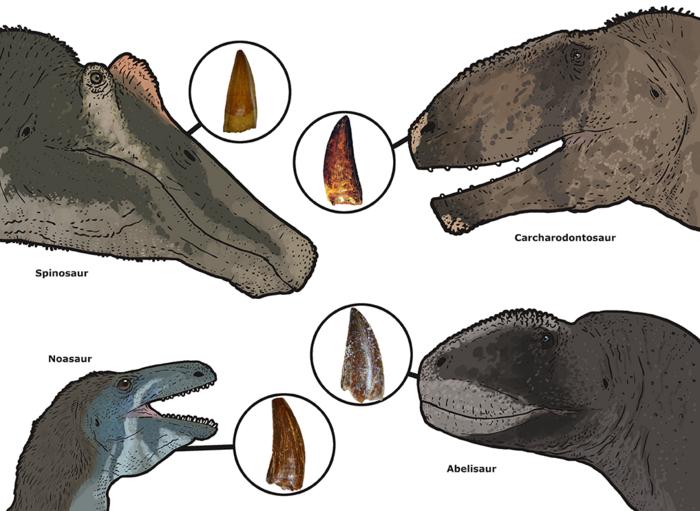Joint press release Utrecht University and National History Museum

Credit: Artwork by Joschua Knüppe.
Joint press release Utrecht University and National History Museum
An international team of palaeontologists from The Netherlands, the UK, Argentina, Germany and Belgium applied recently developed methods to measure theropod (carnivorous) dinosaur species diversity. The newly applied method uses both traditional phylogenetic analysis, discriminant analysis as well as machine learning. This new combination of analyses was performed on teeth of carnivorous dinosaurs, named theropods, from a set of isolated teeth from the famous Cretaceous (~100million years old) Kem Kem beds of Morocco. It turned out to reveal a theropod species previously not found in this area.
Fossilized remains from this site very often comprise teeth, whereas very few dinosaur bones preserve well, leaving scientists often guessing which dinosaur left these teeth behind. Amongst the study specimens were teeth from the famous Spinosaurus and Carcharodontosaurus, known from movies such as the Jurassic Park franchise. Next to these easily recogniseable tooth morphotypes, some ‘mystery teeth’ were also analysed. These teeth were previously classified as belonging to the dromaeosaurid family of Velociraptor fame.
Brand new insights
Simon Wills, a scientific associate at the Natural History Museum who led the research, says, ‘the use of machine learning to identify theropod teeth has thrown the doors wide open to the ecosystem of the dinosaurs that roamed the Kem Kem 100 million years ago. It was fascinating to see how the powerful tool accurately identified the specimens when combined with traditional methods. The process highlights how embracing methods old and new can uncover brand new insights into relatively well-explored areas. I believe we’ll see advances beyond what we thought possible in the coming years as our datasets grow meaning machine learning can reveal more about palaeodiversity and ecosystems from even the smallest remains – such as teeth!’
Close fit
Using the novel technique, the research team tried to determine the closest fit of the teeth’s appearance to other dinosaurs with well-known dentition. The team from Utrecht University, the Natural History Museum, London, Instituto Miguel Lillo in Tucuman, Argentina, the Palaeontological Museum Munich, and VU Brussels then found that the two mystery tooth morphotypes were not the Jurassic Park raptor’s cousins, but rather, belonged to Abelisauridae, a distant cousin of Tyrannosaurus (including the big head and tiny arms), and a clade called Noasauridae, the latter being very rare in Morocco. ‘These teeth had been in museum collections for decades, but this new combination of techniques brought them to life again, and more importantly, confirms the presence of noasaurids in the Kem Kem, thanks to this international team effort,’ says Dr Femke Holwerda of Utrecht University.
Future work
Noasaurids are peculiar small theropods with long necks, and there are only a few hints of isolated bones known from them from the Kem Kem. Traditional methods alone did not find this elusive little theropod amongst the tooth sample. This shows that the new combination of methods is promising for future work on other dinosaurs, such as long-necked dinosaurs, even more rarely found in the Kem Kem.
Kem Kem
The Kem Kem is an Early Cretaceous (roughly 100 million years old) highly fossiliferous site on the border between Morocco and Algeria. It is one of few places in the world that preserves a fairly complete Early Cretaceous dinosaur-dominated ecosystem. Next to a plethora of theropods, sauropod (long-necked) dinosaurs, and one other type of herbivore existed in the area. The ecosystem was riverine, which might be why so many carnivorous animals were supported.
Article
Christophe Hendrickx, Thomas H. Trapman, Simon Wills, Femke M. Holwerda, Koen H.W. Stein, Oliver W.M. Rauhut, Roland R. Melzer, Jeroen van Woensel, and Jelle W.F. Reumer, ‘A combined approach to identify isolated theropod teeth from the Cenomanian Kem Kem group of Morocco: cladistic, discriminant, and machine learning analyses’, Journal of Vertebrate Paleontology, DOI: https://doi.org/10.1080/02724634.2024.2311791.
Journal
Journal of Vertebrate Paleontology
DOI
10.1080/02724634.2024.2311791
Method of Research
Meta-analysis
Subject of Research
Not applicable
Article Title
A combined approach to identify isolated theropod teeth from the Cenomanian Kem Kem group of Morocco: cladistic, discriminant, and machine learning analyses’
Article Publication Date
12-Mar-2024




